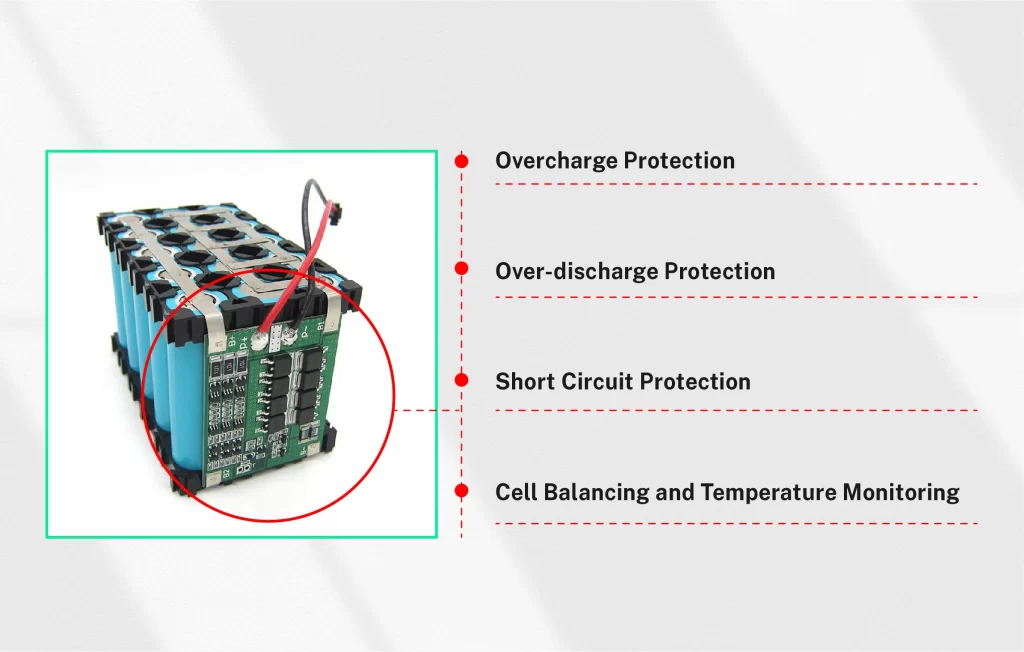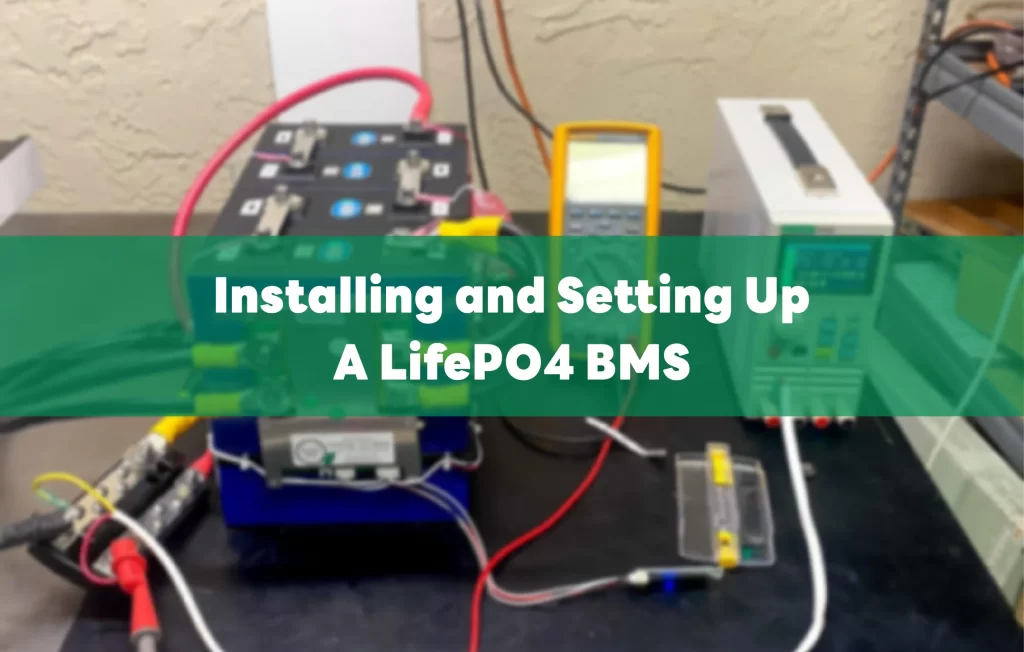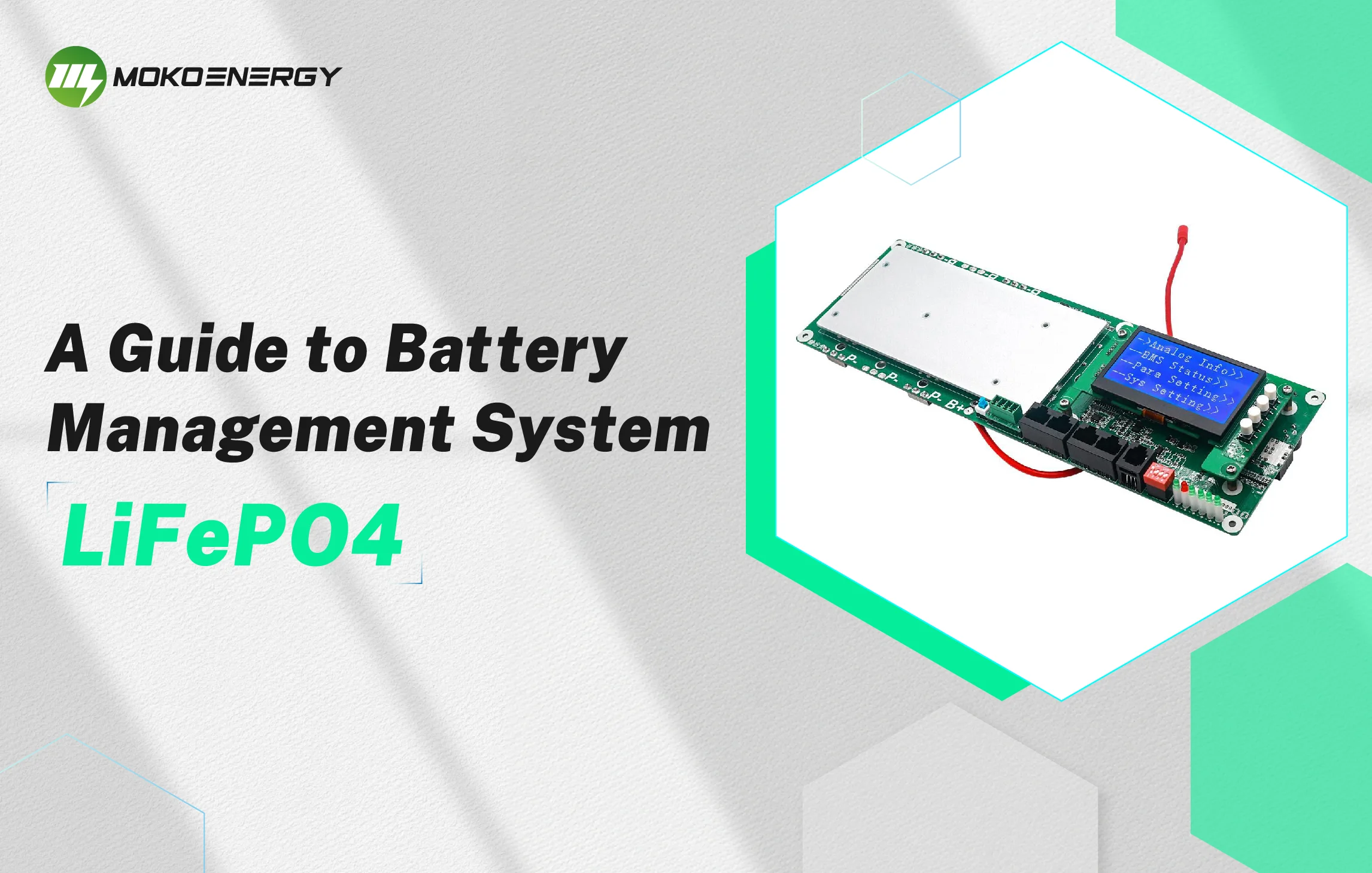LiFePO4 battery is a new type of battery. It has the advantages of large capacity and long life (3-4 times longer than a lead-acid battery). It can cycle charge/discharge more than 2000 times with a fast charging speed, under the condition of 1.5C charging rate, it can be fully charged in 40 minutes, and it can provide a large starting current (bigger than the lead-acid battery and polymer battery). LiFePO4 batteries are rapidly gaining popularity due to their impressive performance, long lifespan, and inherent safety features. However, to truly harness their potential, you need an efficient battery management system for LiFePO4 batteries. Let’s get started to learn what is battery management system LiFePO4 and how it works. We will also give you a guide to installing the BMS on the battery.
I. What Is LiFePO4 BMS?
A battery management system LiFePO4 is an electronic control unit that monitors and regulates the charging and discharging processes of your battery bank. It ensures optimal performance, prolongs battery life, and provides essential safety features to prevent common issues like overcharging, over-discharging, and short circuits.
Key Components and Functions
The LiFePO4 BMS encompass several key components. Each of them contributes to different facets of battery monitoring and protection. Cell monitoring units focus on tracking the voltage and temperature of individual cells, enabling early detection of any faults. Contractors or MOSFETs act as gatekeepers, regulating the charging and discharging processes. Protection circuits vigilantly safeguard against potential risks, such as over-discharging and short circuits, preventing irreversible damage. Balancing circuits work tirelessly to maintain consistency among cell voltages, ensuring optimal performance and longevity. Some advanced systems often incorporate Bluetooth or WiFi connectivity, facilitating remote monitoring and enabling seamless integration with advanced monitoring systems.
| Key Components | Functions |
| Cell Monitoring Units | Track the voltage and temperature of individual cells |
| Contractors or MOSFETs | For charging and discharging control |
| Protection Circuits | Prevent over-discharging and short circuits risks |
| Balancing Circuits | Balance the cell voltages and maintain consistency |
Advantages of LifePO4 BMS Over Other Lithium BMS
Higher Safety: LiFePO4 batteries are used to store large amounts of energy and will tend to overheat, overcharge and overdischarge which in turn will cause thermal runaway, fire, explosion or other catastrophic accidents. LiFePO4 BMS monitors various battery parameters like voltage, current, temperature and SOC and prevents battery thermal runaway from happening. The protection circuits allow battery protect against short circuits risks and battery damage.
Better Performance: LiFePO4 BMS can improve battery performance by maintaining the best charging and discharging rate to avoid overcharge and over-discharge, extend battery life by avoiding deep discharge and overvoltage conditions. It can also provide you SOC and SOH estimation, and help you estimate the remaining run time and the battery’s lifetime.
More Convenient: LiFePO4 BMS can provide you with remote monitoring, wireless connection, programmable settings and other convenient functions to ensure its easy control and use. Fast charging and discharging, save the downtime, increase equipment efficiency.
Key LifePO4 BMS Safety Features

Overcharging Protection: This helps to prevent overcharging that can cause gas build-up, swelling and potential thermal runaway. Once cells reach their maximum voltage limit the BMS stops charging.
Over-discharge Protection: Deep discharges may permanently damage LiFePO4 cells. If battery voltage falls below a safe threshold, the BMS will disconnect loads to prevent over discharge.
Short Circuit Protection: Internal or external short circuits can create high current flows which may result in fire hazards. In case of shorts, the BMS watches the current and disconnects circuitry where necessary.
Cell Balancing Methods: With time slight discrepancies in cell capacities can lead to imbalances. Thus, batteries are balanced actively by BMS for consistent performance and extended life span.
Temperature Monitoring: High temperatures degrade LiFePO4 cells and are dangerous. The battery management system checks cell temperatures and takes appropriate action if need be.
II. LifePO4 BMS Configurations
Cell Arrangements
LiFePO4 battery banks can be configured in different arrangements depending on your power needs and space constraints. The three main cell arrangements are:
| Arrangement | Description | Advantages |
| Series | Cells connected in a line to increase voltage | Higher voltage output, compact design |
| Parallel | Cells connected side-by-side to increase capacity | Higher capacity, redundancy |
| Hybrid | Combination of series and parallel connections | Versatile, balances voltage and capacity needs |
Voltage and Capacity Options
Based on the cell arrangement, LiFePO4 BMSs can be rated for different voltage and capacity outputs to suit various applications:
- -Common voltage options: 12V, 24V, 36V, 48V
- -Typical capacity ranges: 20Ah to 300Ah and higher
Wiring and Connections
Proper wiring can ensure you have a safe and efficient LiFePO4 battery operation. Follow these best practices:
- Use appropriate gauge wires for power cables (lower gauge for higher current)
- Minimize cable lengths to reduce resistance and voltage drop
- Use ring terminals and follow torque specifications for secure connections
- Implement cable management for organization and safety
III. How to Install and Set Up A LifePO4 BMS
A proper installation and setup process ensures that your BMS runs smoothly and optimizes its performance. If you want to install your LiFePO4 BMS, you need to pay attention to some of the following things.

1. Location and Environment
Firstly you need to pay attention to the location and operating environment. You must keep it away from high temperature, humidity or any other situation that may harm it directly. Leave enough space between the parts for good ventilation and easy maintenance.
2. Connecting Cells and Wiring
Connecting the battery cells and wiring is a critical step in setting up your LiFePO4 BMS. Begin by properly connecting the battery cells according to your chosen arrangement (series, parallel, or hybrid). Use high-quality cables rated for the expected current and voltage to minimize resistance and voltage drop. Follow the BMS manufacturer’s instructions carefully for connecting power cables and sensor wires, ensuring secure connections and proper cable management for a tidy and organized setup.
3. Programming and Configuration
Once connected, programming and configuration in accordance with the LiFePO4 BMS manufacturer’s guidelines are necessary. Normally this requires selecting appropriate voltage/current limits depending on battery specifications; adjusting balancing parameters together with temperature cutoffs as well enabling more functions such as Bluetooth monitoring or data logging among others. Correctly setting up is important for safety and efficiency reasons.
4. Integration with Other Systems
Depending on its application there could be a need to integrate this system with other devices or even complete setups themselves. In solar applications connect your BMS with a charge controller plus inverter; if automotive/marine connect with vehicle electrical systems etc. Use CAN or RS485 communication protocols so that remote monitoring and control can be achieved where necessary. Efficient power management over a wide range of installations requires seamless integration across different components
IV. Ways to Get More Out of Your LifePO4 BMS
Boosting Efficiency and Extending Battery Life
- Charge and discharge limits should be set as per the battery specifications.
- Ensure balancing between cells and temperature monitoring is enabled.
- Calibration should be done from time to time; equalization cycles too if recommended.
- Avoid excessive deep discharge cycles and extremely high currents.
Respond to Alerts and Faults
- Warnings such as LEDs or audible alarms should be watched for in the BMS.
- When faced with common error messages, consult the user manual for troubleshooting tips.
- Whenever a problem is identified, act fast on it so that more faults can’t occur or safety is compromised.
Routine Maintenance and Inspection
- Conduct regular inspection of connections, wiring systems, components etc. to detect any signs of damage or weariness early enough.
- Terminals need to be cleaned periodically as well as tightening them so that conductivity does not reduce over time.
- Seals or gaskets that are worn out within the BMS housing must be replaced without delay.
V. Conclusion
In brief, a good battery management system for LiFePO4 is necessary for your battery’s protection, efficiency, and service life. These sturdy and dependable energy storage solutions have several main features, setups, and installation procedures which when understood unlock their full potential.
LiFePO4 batteries and BMS technology will be more important in the future as the demand for sustainable power sources and renewable energy continues rising over time. You can remain current by purchasing an excellent LiFePO4 BMS like those offered by MOKOENERGY today.
Some of the advancements that may feature in battery management systems include but not limited to better thermal control, predictive maintenance using advanced machine learning algorithms among others as well as compatibility with smart home integration systems or even energy management software packages seamlessness among other things.
If you’re thinking about getting into LiFePO4 batteries soon then check out our wide selection of BMSs including MOKOENERGY’s LiFePO4 BMS – there’s something here for everyone! Also don’t forget that it’s always best practice to seek professional advice when making such decisions!
You may also like:






